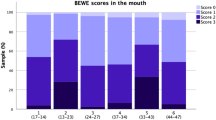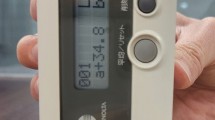Abstract
Objectives
Standard procedure for the measurement of masticatory performance is the fractionated sieving of fragmented test food, which is substantially time consuming. The aim of this study was to introduce a less laborious, comparable, and valid technique based on scanning.
Methods
Fifty-six Optocal chewing samples were minced by wearers of complete dentures with 15 and 40 chewing strokes and analyzed by both a sieving and a scanning method. The sieving procedure was carried out using ten sieves (5.6, 4.0, 2.8, 2.0, 1.4, 1.0, 0.71, 0.5, 0.355, and 0.25 mm) and measuring the weight of the specific fractions. Scanning was performed with a flatbed scanner (Epson Expression1600Pro, Seiko Epson Corporation, Japan, 1,200 dpi). Scanned images underwent image analysis (ImageJ 1.42q, NIH, USA), which yielded descriptive parameters for each particle. Out of the 2D image, a volume was estimated for each particle. In order to receive a discrete particle size distribution, area–volume-conversion factors were determined. The cumulated weights yielded by either method were curve fitted with the Rosin–Rammler distribution (MATLAB, The MathWorks, Inc., Natick, USA) to determine the median particle size X 50.
Results
The Rosin–Rammler distributions for sieving and scanning resembled each other and showed an excellent correlation in 15/40 chewing strokes (r = 0.995/r = 0.971, P < 0.01, Pearson’s correlation coefficient). The median particle sizes varied between 4.77/3.04 and 5.36/5.28 mm (mean 5.07/4.67) for scanning and 4.69/2.39 and 5.23/5.43 mm (mean 5.03/4.57) for sieving. On average, scanning overestimated the X 50 values by 1/2.4 %. The scanning method took 10 min per sample in contrast to 50 min for sieving.
Conclusion
Optical scanning is a valid method comparable to sieving.
Clinical relevance
The described method is feasible and appropriate for the measurement of masticatory performance of denture wearers.





Similar content being viewed by others
References
Lucas PW, Luke DA (1983) Methods for analysing the breakdown of food in human mastication. Arch Oral Biol 28:813–819
van der Bilt A et al (1987) A mathematical description of the comminution of food during mastication in man. Arch Oral Biol 32:579–586
Woda A et al (2006) Adaptation of healthy mastication to factors pertaining to the individual or to the food. Physiol Behav 89:28–35
Speksnijder CM et al (2009) Mixing ability test compared with a comminution test in persons with normal and compromised masticatory performance. Eur J Oral Sci 117:580–586
Slagter AP et al (1992) Force-deformation properties of artificial and natural foods for testing chewing efficiency. J Prosthet Dent 68:790–799
Shiau YY, Peng CC, Hsu CW (1999) Evaluation of biting performance with standardized test-foods. J Oral Rehabil 26:447–452
Kohyama K et al (2004) Effects of sample hardness on human chewing force: a model study using silicone rubber. Arch Oral Biol 49:805–816
Slagter AP, Bosman F, Van der Bilt A (1993) Comminution of two artificial test foods by dentate and edentulous subjects. J Oral Rehabil 20:159–176
Ohara A et al (2003) A simplified sieve method for determining masticatory performance using hydrocolloid material. J Oral Rehabil 30:927–935
Al-Ali F, Heath MR, Wright PS (1999) Simplified method of estimating masticatory performance. J Oral Rehabil 26:678–683
Mowlana F, Heath MR, Auger D (1995) Automated optical scanning for rapid sizing of chewed food particles in masticatory tests. J Oral Rehabil 22:153–158
Mowlana F et al (1994) Assessment of chewing efficiency: a comparison of particle size distribution determined using optical scanning and sieving of almonds. J Oral Rehabil 21:545–551
Eberhard L et al (2012) Comparison of particle-size distributions determined by optical scanning and by sieving in the assessment of masticatory performance. J Oral Rehabil 39:338–348
Slagter AP et al (1992) Comminution of food by complete-denture wearers. J Dent Res 71:380–386
Pocztaruk Rde L et al (2008) Protocol for production of a chewable material for masticatory function tests (Optocal - Brazilian version). Braz Oral Res 22:305–310
Olthoff LW et al (1984) Distribution of particle sizes in food comminuted by human mastication. Arch Oral Biol 29:899–903
Bland JM, Altman DG (1986) Statistical methods for assessing agreement between two methods of clinical measurement. Lancet 1:307–310
Kimoto K, Ogawa T, Garrett NR, Toyoda M (2004) Assessment of masticatory performance. Prosthodont Res Pract 3(2004):33–45
Kayser AF, van der Hoeven JS (1977) Colorimetric determination of the masticatory performance. J Oral Rehabil 4:145–148
Gunne HS (1983) Masticatory efficiency. A new method for determination of the breakdown of masticated test material. Acta Odontol Scand 41:271–276
Nakasima A, Higashi K, Ichinose M (1989) A new, simple and accurate method for evaluating masticatory ability. J Oral Rehabil 16:373–380
Kimoto K et al (2004) Assessment of masticatory performance. Prosthodont Res Pract 3:33–45
Sato H et al (2003) A new and simple method for evaluating masticatory function using newly developed artificial test food. J Oral Rehabil 30:68–73
Sato S et al (2003) Validity and reliability of a newly developed method for evaluating masticatory function using discriminant analysis. J Oral Rehabil 30:146–151
van der Bilt A et al (2010) Comparing masticatory performance and mixing ability. J Oral Rehabil 37:79–84
Yoshida E, Fueki K, Igarashi Y (2007) Association between food mixing ability and mandibular movements during chewing of a wax cube. J Oral Rehabil 34:791–799
Igathinathane C et al (2009) Sieveless particle size distribution analysis of particulate materials through computer vision. Comput Electron Agric 66:147–158
Edlund J, Lamm CJ (1980) Masticatory efficiency. J Oral Rehabil 7:123–130
Julien KC et al (1996) Normal masticatory performance in young adults and children. Arch Oral Biol 41:69–75
Robertson J et al (1984) Particle size analysis of soils—a comparison of dry and wet sieving techniques. Forensic Sci Int 24:209–217
Mowlana F et al (1994) Assessment of chewing efficiency: a comparison of particle size distribution determined using optical scanning and sieving of almonds. J Oral Rehabil 21:545–551
Peyron MA, Mishellany A, Woda A (2004) Particle size distribution of food boluses after mastication of six natural foods. J Dent Res 83:578–582
Fontijn-Tekamp FA et al (2000) Biting and chewing in overdentures, full dentures, and natural dentitions. J Dent Res 79:1519–1524
Conflict of interest
The authors declare no conflict of interest.
Author information
Authors and Affiliations
Corresponding author
Rights and permissions
About this article
Cite this article
Eberhard, L., Schneider, S., Eiffler, C. et al. Particle size distributions determined by optical scanning and by sieving in the assessment of masticatory performance of complete denture wearers. Clin Oral Invest 19, 429–436 (2015). https://doi.org/10.1007/s00784-014-1266-6
Received:
Accepted:
Published:
Issue Date:
DOI: https://doi.org/10.1007/s00784-014-1266-6




